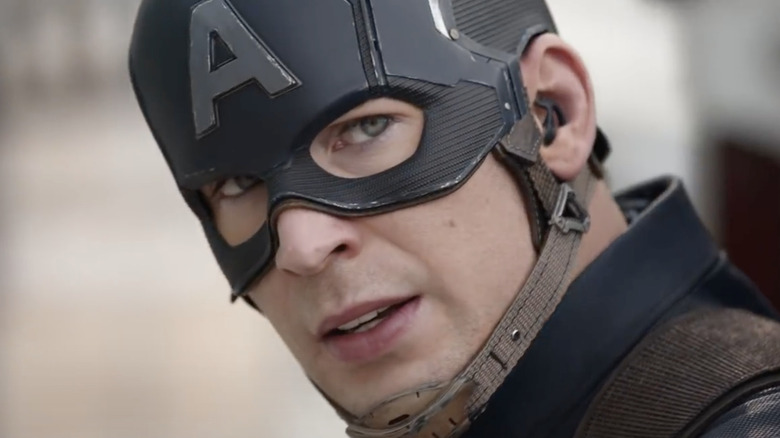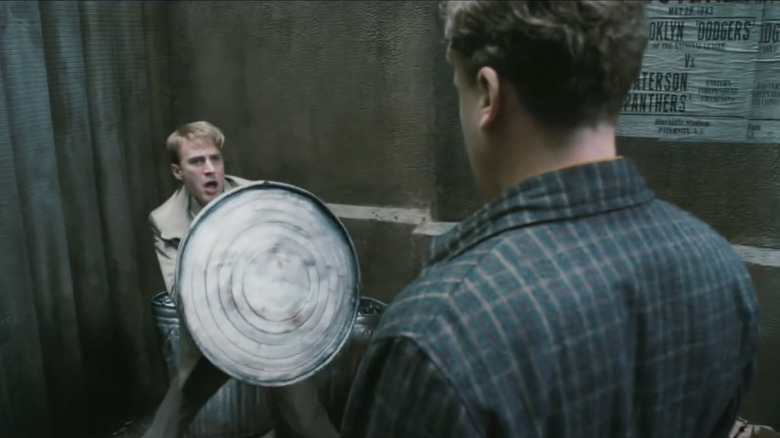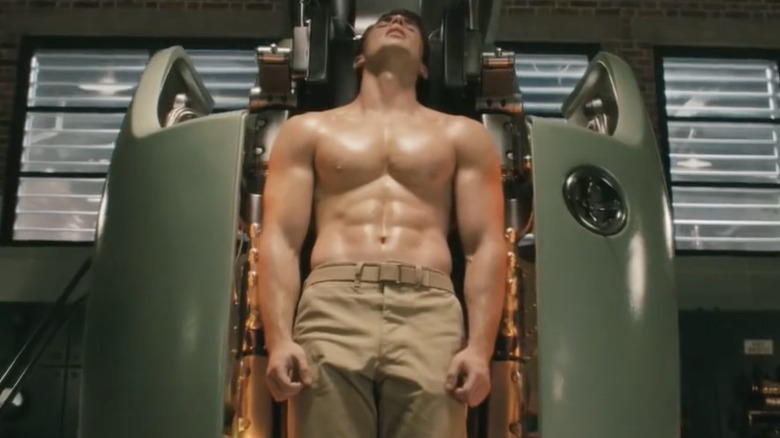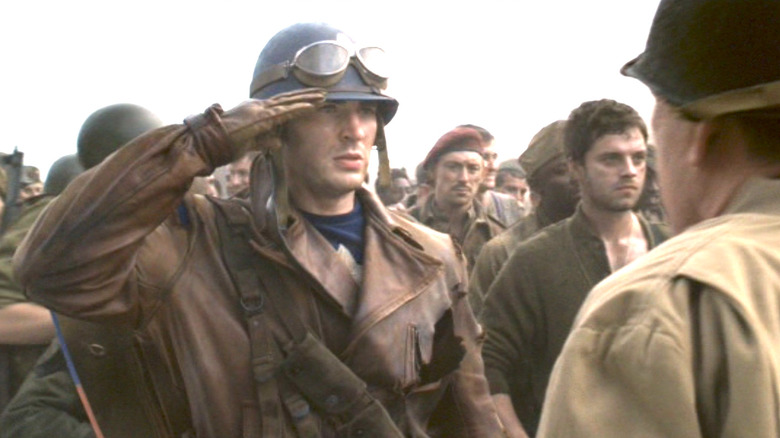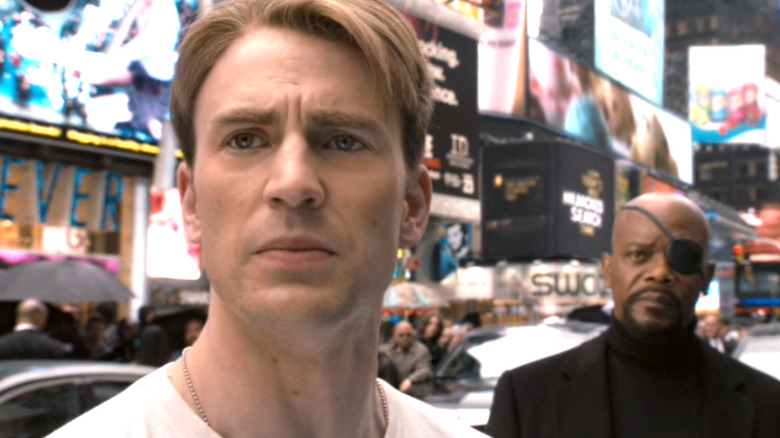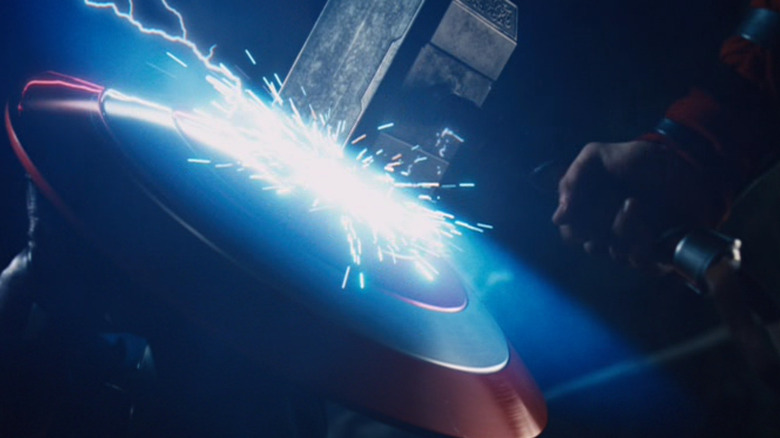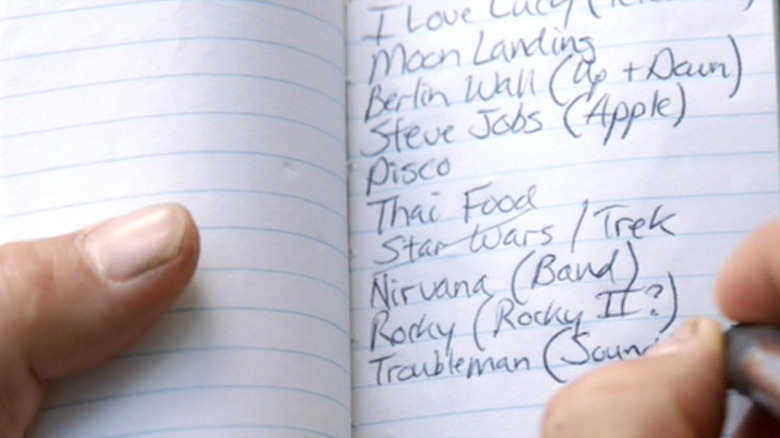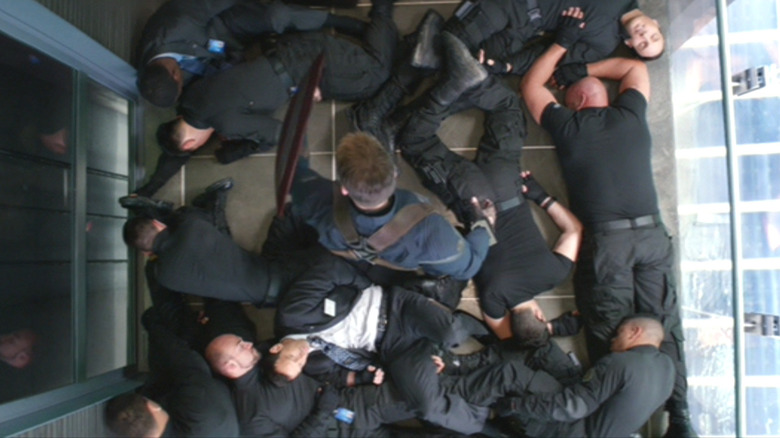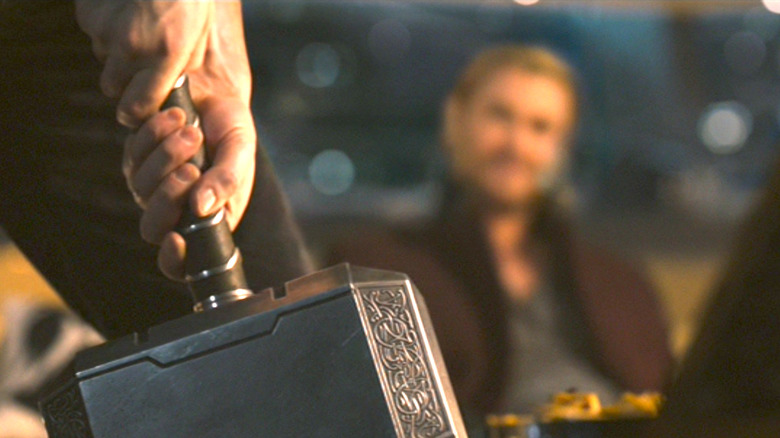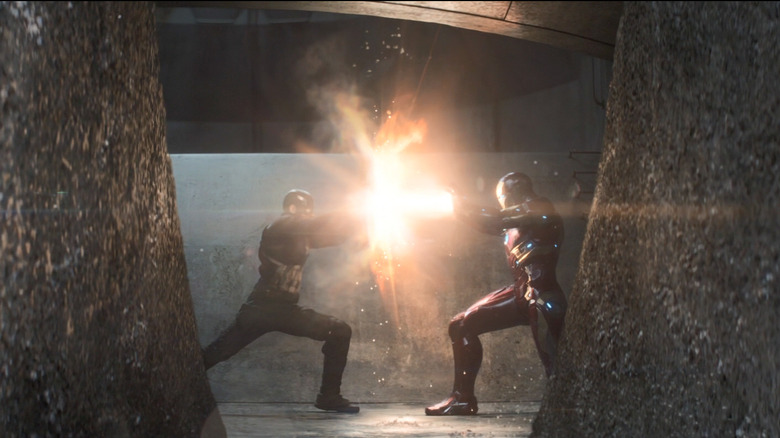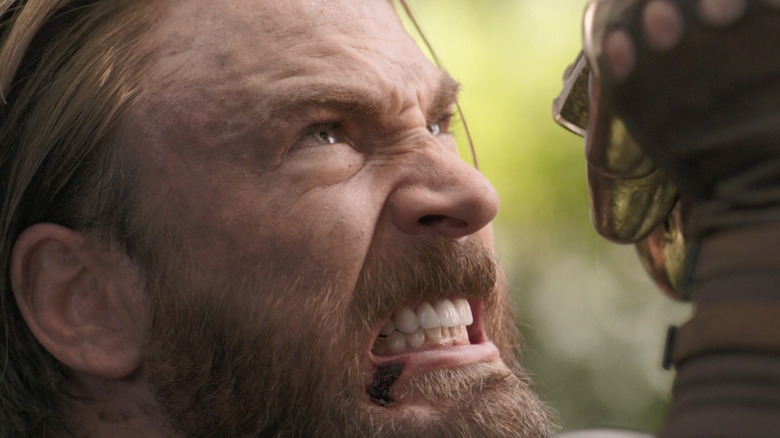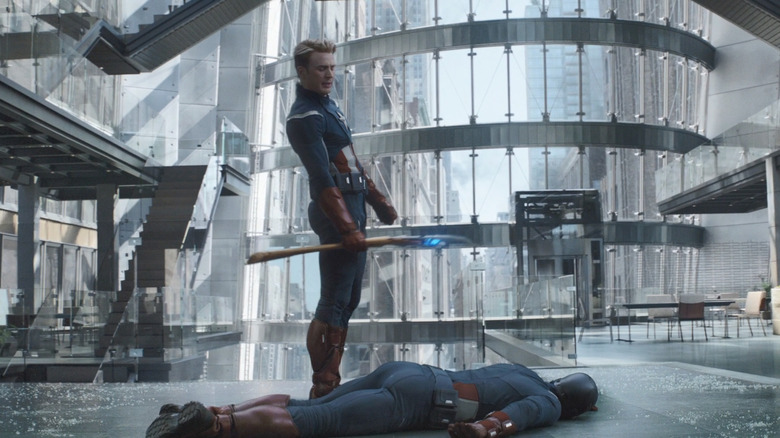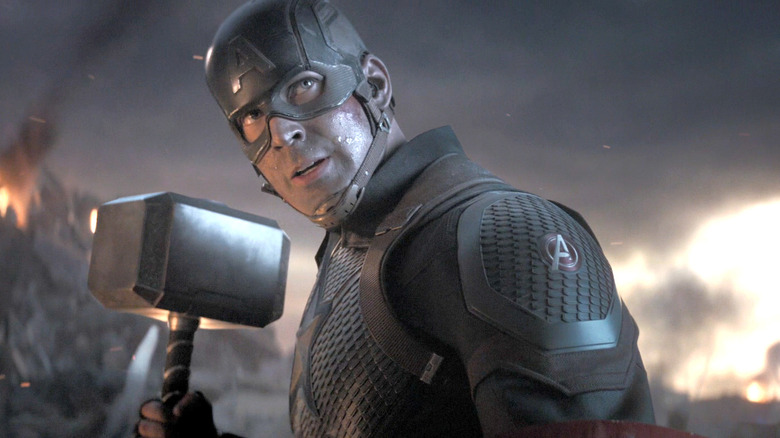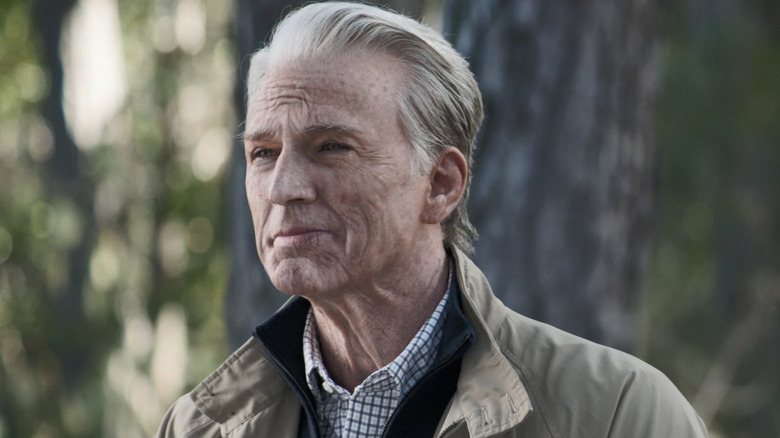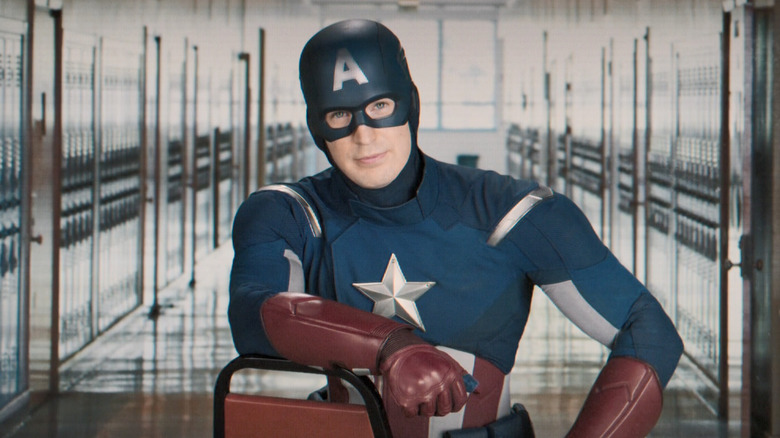The Most Paused Captain America Moments In The MCU
"Captain America: The First Avenger" premiered on July 19th, 2011, two weeks after Independence Day and less than a year before the release of "The Avengers." It was the fifth film in what would come to be known as the Marvel Cinematic Universe, and by the time it came out, it was very clear what Disney and Marvel Studios were up to. The proof was in the title – after all, why would anyone be the first Avenger, if there weren't more Avengers coming later? Captain America was the herald of the MCU's imminent dominance, the final piece of the puzzle to fall into place before Marvel's ambitious project could come to fruition, and the conclusion of his story in 2019's "Avengers: Endgame" signaled the end of an era.
In celebration of Steve Rogers on the tenth anniversary of his arrival, it's time to take a look at the most paused Captain America moments in MCU history. These are not (necessarily) easter eggs – there are many reasons to pause a Captain America film, be they to admire an individual shot, take in the full emotion of the moment, or simply stare at Chris Evans. So, strap on your shield and get ready to jump in without a parachute — but be careful of the devious MCU spoilers lying in wait.
I can do this for seven movies
A list like this has to start with the first time Captain America picks up a shield — but when it happens, it's not really a shield, and he's not really Captain America.
At the beginning of "The First Avenger," Steve Rogers is a small, skinny asthmatic eager to serve his country in World War II but physically incapable of being a soldier. This point is driven home in his introductory scene, when we see him being rejected (again) from the military. But a more important moment is the one that follows, in which Steve confronts a disrespectful bully outside a movie theater.
Featuring his first utterance of "I can do this all day," the scene is symbolic of everything Steve will represent in the years to come: The courage to fight for what's right, regardless of the likelihood of winning. Fittingly, while getting beaten up by the much larger man, Steve picks up a trash can lid and uses it as a shield. It doesn't work, of course, but that one moment foreshadows the existence of Captain America and everything he will come to stand for.
You look taller
As the result of his admirable inner qualities, Steve is ultimately chosen to be the test subject for the latest iteration of Doctor Abraham Erskine's super-soldier serum. In addition to being injected with the serum, the process involves being encased in a technological cocoon and saturated with something called "vita-rays" – an idea that's actually backed up by scientific theory, though the technology doesn't actually exist.
When the doors of the cocoon open, the person inside has indeed been transformed, as the weak and sickly Steve Rogers is now the tall, muscle-bound Captain America. If you don't pause "First Avenger," at least for a few seconds, when Cap is unveiled to the world in all his shirtless glory, we don't even know what to do with you. Not only is it an incredibly important moment in the history of both Captain America and the MCU, but you also just have to stand in awe of Steve's glistening new upper body muscles. We could gaze at those pecs all day.
Let's hear it for Captain America
Of course, even after his transformation, it still takes Steve a little while to fully become Captain America.
Erskine is murdered immediately after the procedure, and he takes the super-soldier program with him, reducing even the enhanced Steve Rogers to a propaganda shill and war bond salesman. The true birth of Captain America comes later, when Steve defies his orders and goes behind enemy lines to rescue the 107th infantry regiment and his best friend, Bucky Barnes, who have been given up for lost. The rescue sequence itself is thrilling, featuring Steve's first showdown with the Red Skull and introducing the Howling Commandos, but the most memorable part comes when the 107th, led by Steve, marches back into camp with their heads held high.
In particular, Steve saluting Colonel Phillips, the man who ordered him not to go and has never truly believed in him, is a profoundly pause-worthy moment – in the face of what Steve has just done, even his greatest detractor is rendered speechless. From that moment on, Steve Rogers is Captain America, and he doesn't stop being Captain America until he gives up the shield in "Avengers: Endgame."
I had a date
We haven't talked about him much so far, but Chris Evans is a superb actor, and his work portraying the character is what has made him a cinematic icon over the course of the past decade.
Case in point: the final scene in "The First Avenger," which sees Steve revived in the modern era after having been frozen in ice for 66 years. When Nick Fury's ploy to ease him in gently fails, Steve escapes onto the streets of New York City, where he can only stare in total bafflement at the sprawling new world to which he's been transported.
The final shot lingers on Evans' masterfully crafted expression of horror and regret as he realizes that everyone he's ever loved is either elderly or dead, and that he is now an ancient symbol of a country he no longer recognizes. The chilling last line, "I had a date," refers to his lost romance with Peggy Carter, but also to his displacement in history — he had a date, like everyone else, and it was 1945. Now that date has passed, but he's still here, set adrift in time.
Withstanding Thor's hammer
The first "Avengers" film is a 144-minute celebration, both of comic books themselves and of Marvel Studios' success in translating comic books to the silver screen. As such – and as the MCU's first team-up movie — it includes the obligatory scene in which two or more heroes meet for the first time and, due to a misunderstanding or charged emotions, start fighting each other.
In "The Avengers," the first occurrence of this trope takes place between Iron Man and Thor, who battle to a stalemate until Captain America arrives to try and cool their heads. He is unsuccessful, however, and Thor leaps to attack him with his mystical hammer Mjolnir. Steve brings up his shield, and as the two legendary weapons collide, both men are blown backwards by the force of one another's power.
The image of Thor's hammer meeting Cap's shield is pause-worthy in and of itself, both in terms of visual aesthetics and as a representative symbol of the film as a whole — but it also the beginning of Steve's relationship with Mjolnir, which will move forward in later "Avengers" movies (and in this list).
Everything you missed
Despite the fact that there's an entire industry-changing movie between "First Avenger" and its sequel, "Captain America: The Winter Soldier," the latter picks up thematically where the former leaves off — with Steve Rogers attempting to find his place in the modern world.
With that in mind, the opening scene of "Winter Soldier" includes one of the most screen-shotted images in MCU history: Steve's to-do list. When Sam Wilson recommends the "Troubleman" soundtrack during their first meeting, Steve pulls out a notebook to add the suggestion to a list he's already begun, comprised of things he's heard about or been told to catch up on. The camera doesn't linger on the list very long, but a well-timed pause reveals it to include "I Love Lucy," the Moon landing, and Steve Jobs.
Or at least, that's what it includes in American and Canadian versions of the film. One of the greatest things about Cap's list is that it changed based on what country "Winter Soldier" was being screened in, including things like "The Fifth Element," Shakira, and various World Cup Finals. Only the last four items above "Troubleman" are always the same: Thai food, "Star Wars/Trek" (with "Star Wars" crossed off to indicate that it was the first thing Steve did, subtle propaganda from the new owners of the "Star Wars" franchise), Nirvana, and "Rocky." It's a great way to emphasize Steve's timelessness, and also a really fun easter egg hunt.
Fail Hydra
Contrary to what you might expect, Marvel films are known more for their resplendent character work and intricate long-term storytelling than they are for their fight scenes.
If there's a blanket criticism to be leveled against the franchise from a purely artistic perspective, it's that their action set pieces tend to feel generic and repetitive, more the work of CGI artists than writers and directors. One massive exception, however, is the elevator fight from "Winter Soldier," which is so well-remembered that it got a subversive callback in "Endgame."
The set-up is breathtakingly simple: Steve is in an elevator with a pack of S.H.I.E.L.D. agents, all of whom are secretly working for Hydra. In a mirror of the larger narrative, everyone is still pretending they're on the same side, until suddenly the pretending is over. The visual design of a distinctly one-sided battle taking place in the cramped quarters of an elevator is perfect, and nothing more so than the final shot of Cap kicking his shield up into his hand as he stands above the fallen forms of no fewer than 10 Hydra sleepers.
If there's any one moment in the MCU that demonstrates Steve Rogers' combat superiority, it's the moment when you realize that the battle was actually one-sided in his favor.
Moving Thor's hammer
In the first "Avengers" movie, Captain America and his vibranium shield take a full-strength hit from Mjolnir and live to tell the tale. In the second, "Avengers: Age of Ultron," Steve does one better.
In the legendary after-party scene, widely regarded as the primary bright spot in an otherwise pedestrian MCU installment, each of the Avengers (apart from Black Widow) take turns trying to lift Thor's hammer off the table after Hawkeye challenges its supernatural nature. Of course, not being worthy, none of them can so much as budge Mjolnir – except for Steve, who shifts it an infinitesimal amount before giving up with a smile.
Whether or not he even knows in that moment that he can lift the hammer is unclear, but Thor certainly does — his expression when the hammer makes its single squeak is priceless to behold, as is his rapid recovery into carefree joviality. The place to hit pause, however, is immediately before Thor's face comes into focus, when the focus is instead on Steve's hand wrapped around Mjolnir's hilt, a beautiful piece of foreshadowing that would pay off in colossal fashion four years later.
War stories
We've discussed the flaws inherent to the MCU's "house style" approach to action scenes, and where this problem consistently looms largest is in the third act of any given Marvel movie, which typically descends into a series of punches, energy blasts, and/or explosions that feel disconnected from the larger narrative.
But the "Captain America" franchise contains another exception to this rule in the form of the climactic fight scene in "Captain America: Civil War," and pausing the film in the moment that Iron Man's repulsor rays blast up against Cap's shield neatly encapsulates what makes this third act different.
It's not just that this shot is a reproduction of the cover of "Civil War #7" (the final chapter in the comic book story that the film is loosely based on), nor is it just the artistic framing of the two heroes. All the fundamental differences between Steve Rogers and Tony Stark that have led to this moment can be seen in the way the two men are posed — Tony on a stable base to anchor him while he uses his weapons, powerful but limited by both his armor and his mindset, while Steve lunges forward, shield raised in defense, slightly smaller and not quite as strong but able to force a stalemate by sheer force of will.
It's the "Avengers" hero fight scene, but with stakes, just as the third act as a whole uses previous character dynamics and history to enliven the traditional Marvel formula.
Infinity war stories
The indominable relentlessness that Steve demonstrates in "Civil War" goes on display again in his next appearance — which is, as it happens, another war.
"Avengers: Infinity War" is centered around the story of Thanos, the Mad Titan, whose deranged desire to destroy half of all life has led him on a quest for the six Infinity Stones. Thanos is by far the strongest enemy the Avengers have ever faced — he trounces the Hulk in the film's opening scene and spends the rest of the movie steadily chewing through every other hero the MCU has to offer until finally coming face-to-face with Captain America.
By this point, Thanos has five of the Stones, meaning he's very nearly the most powerful being in the universe. He was never in danger of being defeated by Steve Rogers. But for a moment, Steve holds out.
Using every ounce of his ironclad will, for just a moment, Steve holds back the Infinity Gauntlet. It's the culmination of everything that has come before, from his hopeless garbage can lid defense to his battle with Iron Man — and even though he's overpowered and knocked aside, for just a moment Captain America made even the inevitable Thanos tremble with doubt and disbelief.
America's ass
Steve appears for the final time in the fourth Avengers movie, "Endgame." It's a title that refers to the conclusion of the original six Avengers, as much as to Doctor Strange's cryptic clues.
The film thusly focuses on those six, and it's a particularly great Captain America movie, climaxing as it does with the long-awaited line "Avengers assemble." Before that, though, comes another moment, perhaps not quite as dramatic, but equally iconic. When the Avengers travel back to 2012 as part of their "time heist" plan to defeat Thanos, they encounter the old versions of themselves from the original "Avengers" film, and in typical Tony Stark fashion, he starts teasing Steve about the costume he was wearing at the time (a meta gag referencing the costume's widespread ridicule among fans). "That suit did nothing for your ass," he says.
Ant-Man leaps to Steve's defense, saying that as far as he's concerned, "that's America's ass!" After Steve defeats his younger self in combat, he privately acknowledges the point, craning his neck to appraise his own backside in one of the great images of modern blockbuster cinema.
Wielding Thor's hammer
If there's one moment in the entirety of the MCU that deserves a pause just so the audience can take a moment to run around, waving their arms and making delighted squealing sounds, it's the moment that Steve Roger not only lifts Thor's hammer, but summons it to his hand, paying off the previous connection between Steve and Mjolnir and proving once and for all that Captain America is worthy.
The set-up is glorious: After knocking Mjolnir out of Thor's hand and taking Stormbreaker for himself, Thanos has the God of Thunder down and is about to kill him with his own axe, when he is suddenly hit from behind by Mjolnir. The hammer then returns to the person who threw it, revealed with a slow turn of the head to be Steve.
Just thinking about it probably makes you want to watch the scene again and pause the moment Cap's face is revealed. His three moments with Thor's hammer form their own trilogy, the moral of which is that, despite the strengths of his teammates, Steve Rogers is definitively Earth's mightiest hero.
Life is beautiful
Just like the last scene of "First Avenger," it's worth pausing on Steve Rogers' face during his penultimate moment in the MCU, which is once again performed with startling power by Chris Evans.
With Thanos defeated and the universe's population restored, Captain America embarks on one final mission, returning the Infinity Stones that the Avengers tracked down during the time heist to their proper places in history. Since he's time traveling, he should only be gone a few seconds, but full minutes pass and he doesn't return — at least, not by the same method.
Sam and Bucky find him sitting on a bench nearby, an old man who has traveled back to 2023 the old-fashioned way. After all, his mission had been to put time-displaced things back where they belong, and that ultimately included himself. When Sam asks if Steve wants to tell him about his life with Peggy, Steve replies, "No, I don't think I will." The look on his face is one of slightly bewildered contentment, the opposite of his expression from "First Avenger," a face mystified by beauty rather than horror.
So, you got detention
The suggested clips above have covered the entirety of Steve Rogers' MCU career, but no list of paused Captain America moments would be complete without the image that spawned a viral meme.
"Spider-Man: Homecoming," one of the funniest movies in the MCU, features a recurring gag of Captain America delivering pre-recorded messages for teachers to play for their students. One of these is shown to kids who get detention, in which Cap lectures his captive audience on the importance of following the rules.
Why is this relevant? Well, the scene in question ended up producing one of internet culture's most enduring memes — to this day, Steve can be seen sternly but patiently correcting people's disappointing behavior all over social media. As a result, it seems that his appearance in "Homecoming" is the single most paused (and subsequently screen-shot) Captain America moment of all time.
